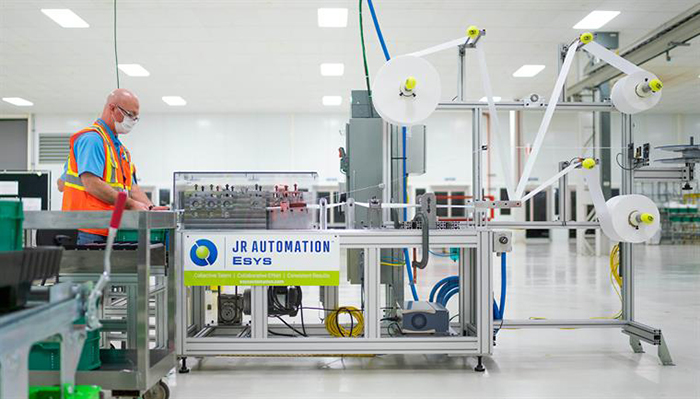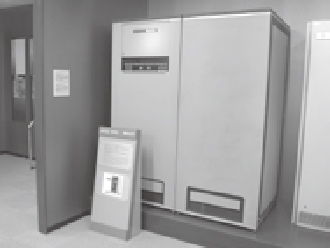(Published 31 March 2021)
Q. The COVID-19 pandemic has focused many discussions on the need to build more resilient social systems and robust supply chains. Dr. Nonaka, what are your views on these urgent societal challenges?
Youichi
COVID-19 has brought about the world's largest economic downturn since World War II, and this is causing the entire globe to think seriously about creating new values and a new world, and to begin taking action on it. In March, in North America, the Hitachi Group's JR Automation launched a face mask production line*1 with its customer in just six days, making a valuable contribution to society. I think such resiliency and adaptability to change will be needed even more in this new world.

(Courtesy of JR Automation)
In the world before the COVID-19 crisis, many social issues were frequently discussed — for example, hunger, poverty, and armed conflict in emerging countries; demographic aging; lower birthrates; societal infrastructure aging; and widening socioeconomic divides in developed countries. With the pandemic, everyone now needs to avoid close contact with other people, and each person must consider how to balance economic risk with the risk to human life and then act on this basis*2. Hitachi is exploring new styles of working and revamping the work environment with an emphasis on the person and on ways of working for every employee*3. Employees and employers need to be able to quickly switch to flexible, people-centric, location-independent workstyles in which productivity is maintained alongside individual happiness and comfort. In support of this, Hitachi is formulating a large number of use cases related to tasks and lifestyles and revamping the work environment based on them. In the post-pandemic world, there will be aspirations for a safe, secure and sustainable world, and for this reason, I think our next big challenge will be to solve environmental problems while also further increasing labor productivity.
Q. Issues in the new society were recently considered by the German-Japanese Experts Meeting for IoT. What specifically was discussed?
Youichi
At that meeting, participants confirmed the goal of not only overcoming the post-COVID crisis but becoming more resilient to such crises that may occur in the future*4. Many countries are discussing being able to address issues such as solving environmental problems and further raising labor productivity in this new society. The meeting participants have focused on this from early on and have launched a joint Japanese-German project with the German Academy of Science and Engineering (acatech), a key proponent of Industry 4.0. Through the project, participants discussed how humans and machines could interrelate in the new society, and published these discussions globally in a discussion paper*5.

For this project, which was conducted over the course of a year, experts from Japan and Germany discussed a host of issues. These included digital support for person-to-person technology transfer, the deterioration of people's skills when there is too much support from machines, working formats that assume human-machine collaboration, and how to structure a sustainable society with human diversity and diverse machinery. The project proposed the concept of creating a safe, secure and sustainable society by building mechanisms in society by which humans and machines enhance one another.
The project's discussions generated many interesting insights. In particular, the discussions reaffirmed that although creating a safe, secure and sustainable society is a common goal of Japan, Germany, and many other countries, different countries, regions, communities and individuals have different historical and cultural backgrounds, politics and lifestyle patterns. As a result, there are untold numbers of routes and methods for arriving at the same shared goal. With respect to mechanisms by which humans and machines enhance one another, which will be required by the world going forward, the project had an acute sense that providing the most advanced IT and cutting-edge automation technology alone would not necessarily constitute a true contribution to society.
Q. How has Hitachi worked to make social contributions through automation?
Youichi
Since our founding, we at Hitachi have contributed to society by not only creating automation-related technologies but also by using the technologies ourselves.

Hitachi began making motor control equipment and switchboards around 1914. In 1933, we began supplying section steel rolling mills made with purely domestic technologies to Yahata Steel Works (known today as Nippon Steel Corporation). This marked our full-fledged entry into the field of automation.
Establishing this firm foundation in control technology led to business expansion in the latter part of the 1950s. With the development of large-scale, general-purpose computers in the 1960s, Hitachi developed the HITAC 7250 digital computer for large-scale control in 1967, the first of its kind in Japan. This computer had the durability, reliability and availability needed to operate under strict conditions like those at factories.

As large-scale integration (LSI) technology advanced in the late 1970s, we developed controllers with internal microprocessors and created a distributed control system. In this system, a factory's devices are outfitted with control equipment, are interconnected, and monitor one another. Next, Hitachi developed autonomous distributed control technology to combine multiple control systems into a network and conduct overall coordination; although each system operates autonomously, they all function as a single system. This technology supports large-scale train operation control systems, including the Computerized Safety Maintenance and Operation Systems of Shinkansen (COSMOS), which went into operation in 1995. Another such system is the Autonomous Decentralized Transport Operation Control System (ATOS), which went online in 1996, as well as various other control systems used in industrial and societal infrastructure domains.
As automation of individual devices progressed in this way, factory automation (FA) emerged to raise production efficiency by connecting those devices into single production lines. Hitachi quickly established a mass production line for video tape recorders, which connected complex processes with a high level of assembly difficulty. Through building this line, we developed the assemblability evaluation method (AEM), which evaluates the relative ease of product assembly based on the product's structure. When used in product design, this evaluation method makes it possible to create structures that are easy to assemble on FA lines. After gaining a track record internally, Hitachi licensed the technology in 1980 to General Electric in the U.S.
Around this time, as consumer needs diversified, Monozukuri began shifting from mass production to high-mix, low-volume production. By using IT to coordinate information at different stages — from order reception to product delivery — Hitachi built a comprehensive computer-integrated manufacturing (CIM) system to achieve highly efficient production that could flexibly adapt to demand fluctuations. With the development of supply chain management (SCM) in the second half of the 1990s, this led to business process reforms on a global scale.
We were involved early in strengthening software development capabilities, including embedded systems, and raising its productivity. Hitachi also gained early traction in computer-aided design (CAD), computer-aided engineering (CAE), design automation (DA), computer-aided manufacturing (CAM) and numerical control (NC) processing. We verified technologies at many factories for semiconductor devices, liquid crystal displays, hard disk drives, large machinery, elevators and escalators, home appliances and other products, accumulating the know-how to combine them with Monozukuri expertise.
Hitachi is currently digitalizing production system expertise and know-how to optimize production processes with data analytics. Attempts are also being made to horizontally extend that know-how to multiple sites within the company and develop it out into other industrial sectors. Realizing secure and seamless information exchange and real-time data analysis and feedback between multiple companies will make it possible to connect an entire value chain. This in turn enables the companies to share detailed analyses of market needs with suppliers (even those farthest upstream) and utilize those analyses in timely product planning, production optimization, and increased logistics efficiency. In the future, it will enable multiple companies to share production assets for more effective resource utilization.
For example, flexibly sharing production resources between companies when they are needed, for the time they are needed, makes it possible to accommodate diversifying customer needs while maintaining a production system with high operating rates. This is the new “cloud manufacturing” production system. Hitachi conducted joint research toward the realization of this system with Germany's Fraunhofer Institute and the Hungarian Academy of Science. The research resulted in the development of technology that enables secure production resource sharing between companies while concealing important information like quantities and processing specifications. This was registered as a use case for the joint Germany-Japan IoT Collaboration Project.
Q. How do you see the future of automation?
Youichi
Hitachi is committed to extending automation technology, Monozukuri expertise, and the combined know-how that has been cultivated to Hitachi's global business. As discussed at the German-Japan IoT Collaboration Project Meeting, everyone must move toward the common goal of achieving a safe, secure and sustainable society with solutions tailored to specific conditions based on regions' historical, cultural, and political differences as well as differences in lifestyle patterns.
This requires the latest automation technology and a further expansion of our Total Seamless Solutions, Hitachi's vision for total optimization beyond the seams of different types of processes and technologies based on operational knowledge. We must provide total seamless solutions in the broad sense, in close connection with regional needs, to the entire world via Hitachi's Lumada solutions.
To accomplish this, it will be necessary not only to polish our technologies and expertise but also to actively interact and exchange with cutting-edge research labs and open consortiums in each region. This will enable us to evaluate our own technological capabilities, create personal networks and expand the ecosystem for research. To build trust will require getting directly involved at the sites of these partners and their customers in the regions and further increase our knowledge.
This openness, in other words, will be the key to our research and development. Hitachi will actively engage internally and externally with an open mind, create an open ecosystem, lead open innovation that generates societal change, and put this into practice. We will continue active initiatives under this policy going forward.
Automation is one of the technologies that holds great promise for solving today's real-world problems. Hitachi is collaborating with customers, partners, and educational institutions worldwide to develop innovative automation solutions that build on new connectivity capabilities to create contactless work environments for greater worker safety and security. Our commitment to powering good drives us to relentlessly pursue collaboration that contributes to a better future for all. These conversations bring together experts and thought leaders to explore the exciting advances that are happening today while sharing how Hitachi and others are approaching economic, societal, and environmental changes for a brighter future.
(As at the time of publication)

Youichi NONAKA, Ph.D. (Eng.)
Senior Chief Researcher,
Hitachi, Ltd.
Nonaka joined the Production Engineering Research Laboratory of Hitachi, Ltd. in 1992, working in R&D for industrial robot application systems, digital engineering technology, and production control technology. He was a visiting researcher at the Massachusetts Institute of Technology in 2001, assumed his current position as Senior Chief Researcher in the Center for Technology Innovation — Production Engineering in 2015.